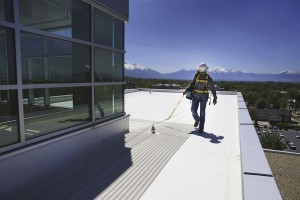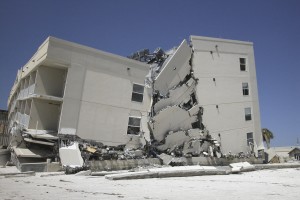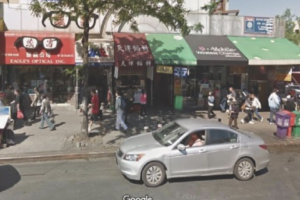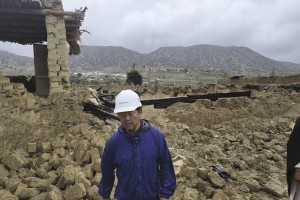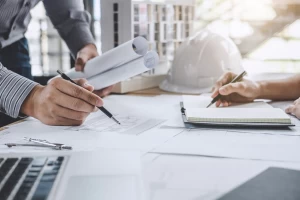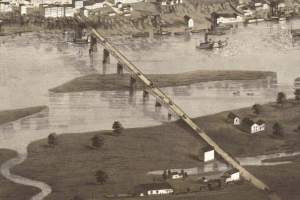This article provides background on the seismic design of cross-laminated timber (CLT) shear wall systems following ASCE 7-22 Minimum Design Loads and Associated Criteria for Buildings and Other Structures and ANSI/AWC Special Design Provisions for Wind and Seismic (SDPWS) 2021 Edition. The SDPWS is referenced in the 2021 International Building Code (IBC), and both SDPWS and ASCE 7-22 will be referenced in the 2024 IBC.
…Review Category : Articles
Fall from height represents one of the highest occupational hazards in general industry and at construction sites. Personal fall protection equipment is frequently used to abate this hazard as part of a fall arrest or travel restraint system, where the point of anchorage is a critically functional part of this operation. However, what is the role of the structural engineer in the overall design of fall safety systems? Proper understanding of structural implications and other design aspects is vital to the individuals who trust their livelihood each time they engage to a fall protection anchorage system.
…Why pull-off tests and tensile strengths do not allow statements about adhesive bonding efficiency.
…Forensic structural engineering involves the investigation and determination of the causes of a failure of structures such as bridges, buildings, industrial structures, and metro stations. (Figure 1). Along with understanding the legal procedures and giving testimony, forensic structural engineers use their knowledge and experiences in these investigations to act as a detective, investigator, and expert witness when confronted by attorneys and other opposing experts during the litigation process.
…Since 1980, when a periodic façade inspection and repair program (Local Law 11) was legislated in New York City (NYC), five fatalities have been caused by facades of buildings whose inspection is mandated by the program. Over the same period, there were five fatalities due to the collapses of parapets to which business signs were affixed. However, when a similar fatal accident involving a business sign occurred in the neighboring Westchester County, the New York Times reported that the Yonkers Fire Chief qualified it as a freak accident. Questioning this assertion, this article provides an overview of sign-related incidents in NYC and offers explanations of the most likely causes of fatal accidents.
…A 6.2 magnitude (Mw) earthquake struck southeastern Afghanistan on June 22, 2022. It was felt over a wide area, most strongly affecting the Paktika and Khost provinces and parts of neighboring Pakistan. According to the USGS, the earthquake had a maximum Modified Mercalli Intensity of VIII (Severe). Over 1,100 people died, and over 6,000 others were injured, making it the country’s deadliest earthquake in over 20 years.
…As design-build continues to gain increasing use as a project delivery method, structural engineers should be aware of the added risk lurking in the design-build contract. Disproportionate risk allocation and an elevated standard of care are two primary culprits in expanding the engineer’s risk exposure. Much of this risk can be managed with fair and carefully worded contracts that cover the design-build project and any design services performed prior to contract award. Close attention to the provisions of the design-builder’s contract with the owner that flow down to the engineer’s contract is also essential in confining the engineer’s risk to a reasonable level.
…Creating a culture of accountability, like most human conundrums in leadership, often makes the most expert and senior leaders want to throw up their hands in frustration and give up. “Why don’t they just do what I told them to do?” “But it’s clearly written in their role description?” “Why am I asking this same question three months later?” And narrowing down a definition of accountability can be difficult, depending on who is part of the conversation. So, for this article, let’s define accountability as a shared understanding that people are responsible for executing their commitments.
…David Cocke started Structural Focus over twenty years ago in Los Angeles and has grown the firm to nearly 30 employees. David received his B.S. from Virginia Tech and his M.S. from San Jose State University. He is a registered Structural Engineer in California and several other states, with expertise in seismic evaluations and retrofits, historic preservation, and new design.
…19th Century Mississippi River Bridges Series
St. Paul, originally called Pig’s Eye, was founded approximately 13 miles downriver from Minneapolis near Fort Snelling. It was the northernmost access on the navigable river for steamboats on the Mississippi. It was settled on the north (east) bank of the Mississippi, on a bluff overlooking the river with low lands to the south (west bank). In 1849, the city was incorporated, and steamboat landings increased rapidly in the early 1850s. Its population reached almost 5,000 people by 1850. The river at the site was divided by Raspberry Island. Passage across the river was by rope ferries, and it soon became apparent that a bridge was necessary if the city continued to grow. As early as 1849, pressure to build a bridge started, and, in 1854, the Territorial Legislature passed Chapter 30, An Act to Incorporate the Saint Paul Bridge Company, on March 4. Sections 12, 14, 15, and 18 stated in part:
…

